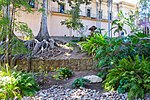Fleet Science Center
1970s architecture in the United States1973 establishments in CaliforniaAssociation of Science-Technology Centers member institutionsBalboa Park (San Diego)IMAX venues ... and 5 more
Museums established in 1973Museums in San DiegoPlanetaria in the United StatesScience museums in CaliforniaSpanish Colonial Revival architecture in California

The Fleet Science Center (previously the 'Reuben H. Fleet Science Center') is a science museum and planetarium in Balboa Park, located in San Diego, California. It is at the east end of the El Prado Drive walkway, next to the Bea Evenson Fountain and plaza in central Balboa Park.Established in 1973, it was the first science museum to combine interactive science exhibits with a planetarium and an IMAX Dome (OMNIMAX) theater, setting the standard that most major science museums follow today.
Excerpt from the Wikipedia article Fleet Science Center (License: CC BY-SA 3.0, Authors, Images).Fleet Science Center
Plaza de Balboa, San Diego
Geographical coordinates (GPS) Address Website External links Nearby Places Show on map
Geographical coordinates (GPS)
| Latitude | Longitude |
|---|---|
| N 32.730812 ° | E -117.146971 ° |
Address
Reuben H. Fleet Science Center (The Fleet)
Plaza de Balboa
92134 San Diego
California, United States
Open on Google Maps










